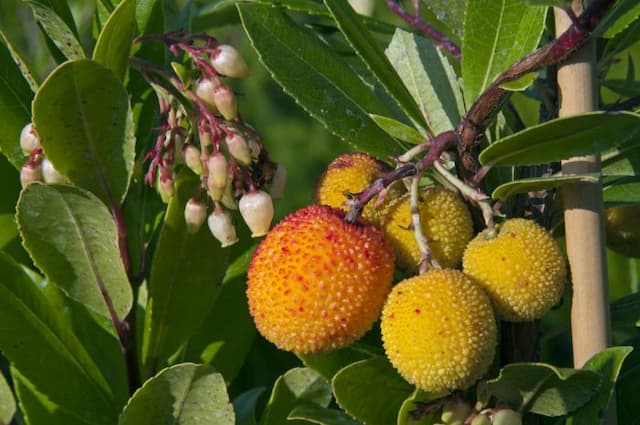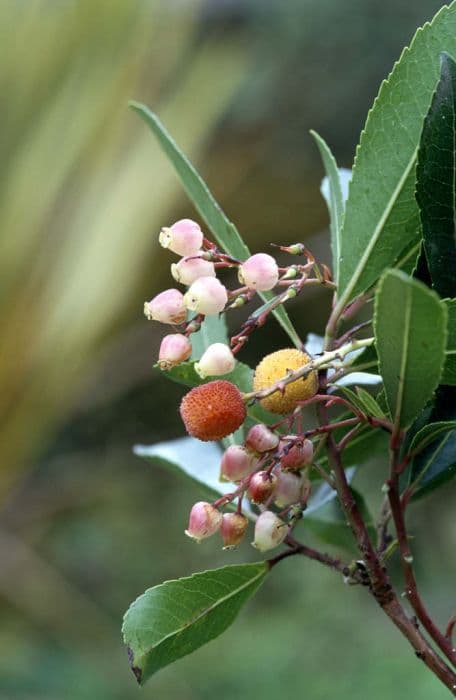Burning Love Leucothoe Leucothoe keiskei Burning Love = 'Opstal50' (PBR)

ABOUT
Leucothoe keiskei 'Burning Love', commonly known as Dog Hobble, is an ornamental shrub known for its striking foliage. The leaves of this cultivar are particularly noteworthy for their vivid colors; young leaves emerge with a fiery red hue, while mature foliage transforms into a deep green with purplish undertones. The contrast between the new and old leaves creates a dynamic and visually appealing display throughout the growing season. The leaves are elongated, with a glossy texture and a slightly wavy margin, giving them an elegant and lustrous appearance. The Dog Hobble 'Burning Love' also produces modest flower clusters that dangle delicately under the arching branches, adding a subtle charm to the plant's overall aesthetic. The flowers are usually small, bell-shaped, and typically a creamy white color, complementing the dramatic foliage. This plant, with its colorful presentation and lush foliage, brings a sense of vibrancy and texture to gardens and landscapes.
About this plant
 Names
NamesFamily
Ericaceae
Synonyms
Burning Love Leucothoe, Drooping Leucothoe
Common names
Leucothoe keiskei 'Opstal50'
 Toxicity
ToxicityTo humans
The Burning Love (Leucothoe keiskei) is considered to have some level of toxicity to humans. If ingested, parts of this plant can cause stomach upset, nausea, vomiting, and diarrhea. Handling the plant can sometimes lead to skin irritation or allergic reactions in sensitive individuals. Hence, it is advisable to exercise caution around this plant to avoid accidental ingestion or prolonged skin contact, especially with children who might be tempted to put parts of the plant in their mouths.
To pets
The Burning Love (Leucothoe keiskei) is known to be toxic to pets as well. If pets consume parts of this plant, they might exhibit symptoms of poisoning which could include vomiting, diarrhea, hypersalivation, and weakness. In some cases, consumption could potentially lead to more severe symptoms depending on the quantity ingested and the sensitivity of the individual animal. It is important to prevent pets from chewing on or ingesting parts of this plant to ensure their safety.
 Characteristics
CharacteristicsLife cycle
Perennials
Foliage type
Evergreen
Color of leaves
Mixed
Flower color
White
Height
1-2 feet (30-60 cm)
Spread
1-2 feet (30-60 cm)
Plant type
Shrub
Hardiness zones
5
Native area
Japan
Benefits
 General Benefits
General Benefits- Attractive Foliage: Leucothoe Burning Love has vibrant red and green leaves that provide all-year-round interest in the garden.
- Compact Growth: With its compact habit, it is suitable for small gardens or spaces where a plant is needed that will not overgrow its welcome.
- Low Maintenance: This plant requires minimal care once established, making it ideal for busy gardeners or those who prefer low-maintenance landscapes.
- Shade Tolerance: It thrives in shady areas where many other plants struggle, making it a good choice for understory planting or north-facing gardens.
- Versatility: Can be used in a variety of garden settings including borders, containers, and as ground cover, offering design flexibility.
- Winter Interest: It maintains its leaf color and structure during winter months, providing color and texture when other plants may be dormant.
- Deer Resistance: Leucothoe Burning Love is less appealing to deer, reducing the likelihood of damage from these garden visitors.
- Disease Resistance: It shows resistance to many common plant diseases, avoiding the need for frequent treatments.
- Soil Adaptability: Adapts to various soil conditions, although it prefers well-draining, acidic soils, making it easier to incorporate into different garden setups.
- Attracts Wildlife: The flowers can attract pollinators such as bees, bringing life and supporting biodiversity in the garden.
 Medical Properties
Medical PropertiesThis plant is not used for medical purposes.
 Air-purifying Qualities
Air-purifying QualitiesThis plant is not specifically known for air purifying qualities.
 Other Uses
Other Uses- Photography Prop: Burning Love can add a vibrant touch to garden photography due to its striking foliage and compact growth habit.
- Privacy Screening in Miniature Gardens: Small enough for container growing, it can be used to create a sense of seclusion in fairy gardens or other miniature landscapes.
- Educational Tool: Due to its unique features, Burning Love can be used to teach principles of plant care and horticulture in schools and workshops.
- Arts and Crafts: Its colorful leaves can be incorporated into floral arrangements or used as inspiration for botanical drawings and paintings.
- Theme Gardens: Its vivid colors make it a perfect addition to thematic garden displays, such as a 'fire-themed' garden highlighting warm colors.
- Sensory Gardens: With its varying textures, Burning Love can contribute to gardens designed for sensory stimulation.
- Culinary Garnish: While not edible, its leaves can temporarily adorn dishes for decorative purposes in high-end culinary presentations.
- Landscape Contrast: As a ground cover, it can provide contrast against other green plants or complement autumn landscapes with its foliage.
- Gifting: A potted Burning Love can be an unconventional gift for plant enthusiasts looking for unusual and attractive plants.
- Winter Interest: The evergreen nature of Burning Love provides color and life to gardens that otherwise look barren during cold seasons.
Interesting Facts
 Feng Shui
Feng ShuiLeucothoe is not used in Feng Shui practice.
 Zodiac Sign Compitability
Zodiac Sign CompitabilityLeucothoe is not used in astrology practice.
 Plant Symbolism
Plant Symbolism- Passion: The variety name 'Burning Love' suggests a strong connection with emotions and passion, as burning is often a metaphor for intense feeling.
- Transformation: Many plants, including Leucothoe keiskei, undergo seasonal transformations, which can symbolize change and renewal in life.
- Adaptation: This plant is known for its ability to grow in various conditions, representing adaptability and resilience in the face of change.
- Beauty: Appreciated for its ornamental value and attractive foliage, it symbolizes the appreciation of beauty in its various forms.
 Water
WaterFor the Leucothoe keiskei 'Burning Love', also known as Dog Hobble, maintain even moisture for the plant by watering it thoroughly whenever the top inch of soil feels dry to the touch. On average, this may mean watering once every 1 to 2 weeks, but this can vary with environmental conditions. In general, provide about 1 gallon of water for an average-sized plant, adjusting according to the pot size and the plant's environment. During hot, dry spells, you may need to water more frequently, and less often when it’s cold or overcast. Ensure that water penetrates deeply into the soil to encourage a strong, healthy root system.
 Light
LightDog Hobble prefers partial to full shade, making it ideal for shaded garden spots or under the canopy of larger trees. Avoid direct sunlight, especially during the hottest part of the day, as this can scorch the foliage and cause stress to the plant. The most suitable location for this plant is one where it can receive filtered light or morning sun followed by afternoon shade.
 Temperature
TemperatureDog Hobble thrives best in temperatures between 40 to 85 degrees Fahrenheit. It is hardy and can endure temperatures as low as 0 degrees Fahrenheit for brief periods but growth and health can be compromised at these extremes. Ideal conditions are temperate and should avoid the stress of fluctuating extremes, maintaining a fairly steady range that does not frequently challenge its minimum or maximum tolerances.
 Pruning
PruningPrune Dog Hobble in late winter or early spring before new growth begins to shape the plant and remove any damaged or dead branches. This encourages healthy growth and improves air circulation. It typically does not require extensive pruning, but selectively thinning out crowded branches every few years helps maintain its appearance and vigor. After flowering, you can lightly trim the plant to keep it tidy, if desired.
 Cleaning
CleaningAs needed
 Soil
SoilLeucothoe 'Burning Love' thrives in a well-draining, acidic soil mix with a pH of 5.0-6.0. A good mix for this plant would be equal parts of peat moss, pine bark, and perlite to ensure proper drainage and maintain acidity.
 Repotting
RepottingLeucothoe 'Burning Love' should be repotted every 2-3 years to refresh the soil and allow space for root growth, ensuring to handle the roots gently.
 Humidity & Misting
Humidity & MistingLeucothoe 'Burning Love' prefers a humid environment, ideally with humidity levels of 50-60% for optimal growth and to maintain the health of its foliage.
 Suitable locations
Suitable locationsIndoor
Bright indirect light, humid area, acidic soil, away from heat sources.
Outdoor
Partial shade, acidic soil, protected from strong winds, mulched.
Hardiness zone
5-8 USDA
 Life cycle
Life cycleLeucothoe keiskei 'Burning Love' begins its life cycle as a seed, which under appropriate conditions of moisture and temperature, will germinate and develop into a seedling. As the seedling grows, it develops a root system and sprouts its first leaves, entering the vegetative stage where the plant will focus on growth and leaf production. During this phase, it forms a bushy habit with its characteristic dark red leaves. As it matures, the plant enters the reproductive stage, characterized by the formation of flower buds that bloom into small white urn-shaped flowers, generally in spring. Once pollination occurs, the plant sets seeds which, when mature, are dispersed to begin a new cycle. After several years, Leucothoe keiskei 'Burning Love' reaches maturity and may eventually start to decline in vigor, which is a natural part of its perennial lifespan.
 Propogation
PropogationPropogation time
Spring-Early Summer
Leucothoe keiskei Burning Love, more commonly known as Drooping Leucothoe, is typically propagated through softwood cuttings. This popular method involves taking cuttings from the plant's new growth in late spring to early summer when the stems are still tender and flexible. To do this, one should select a healthy stem and make a cut about 4 to 6 inches long just below a leaf node. The lower leaves are removed, and the cut end is often dipped in rooting hormone to encourage root growth. Then, the cutting is inserted into a pot filled with a mix of peat and perlite or a similar rooting medium. The environment should be kept humid and the soil moist, but not soggy, as the cutting begins to root. This process typically takes several weeks, after which the young plant can be gradually acclimated to less humid conditions and eventually planted in a permanent location.









